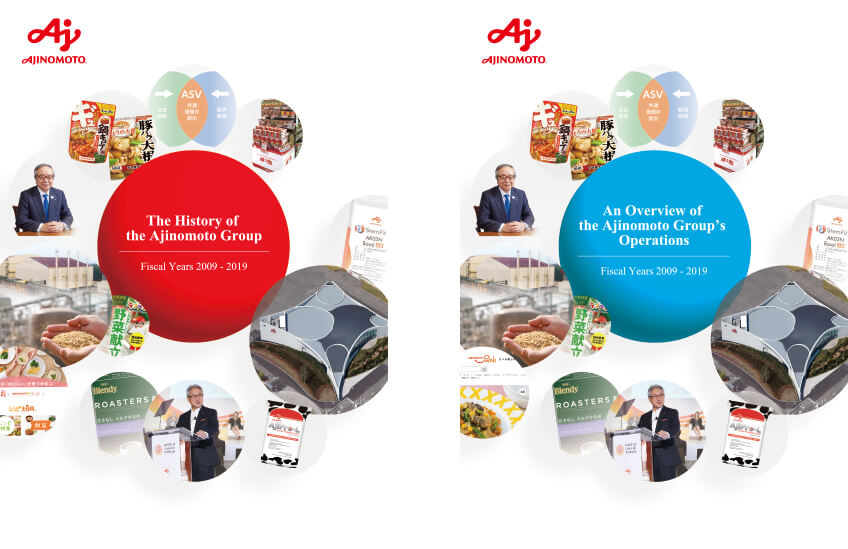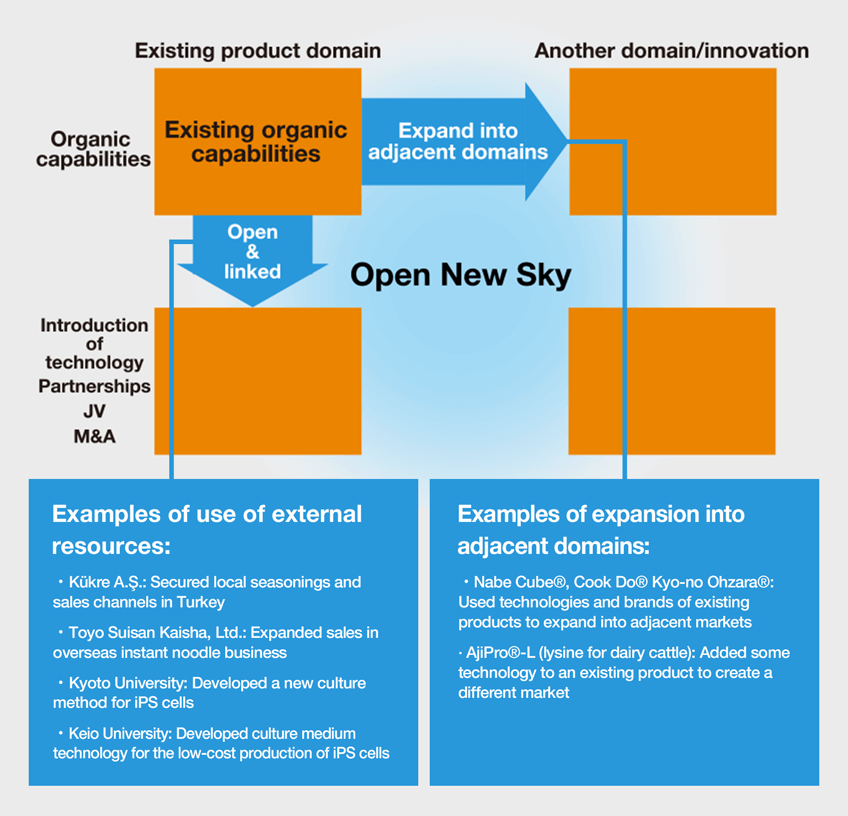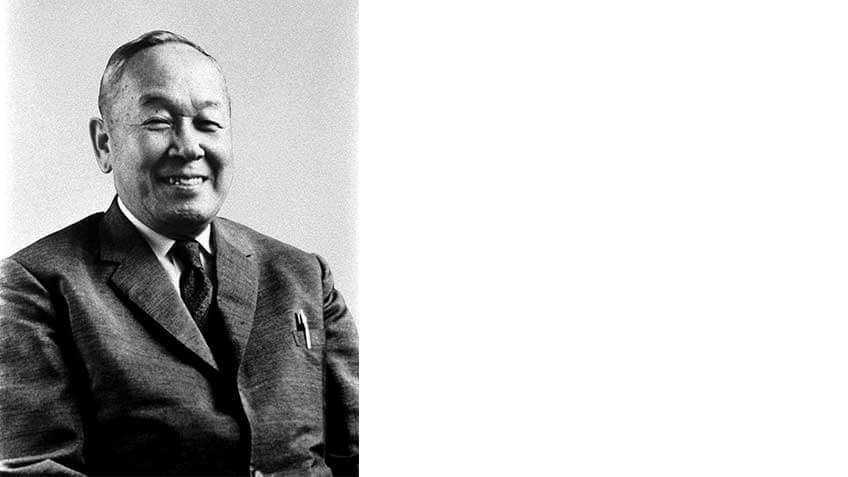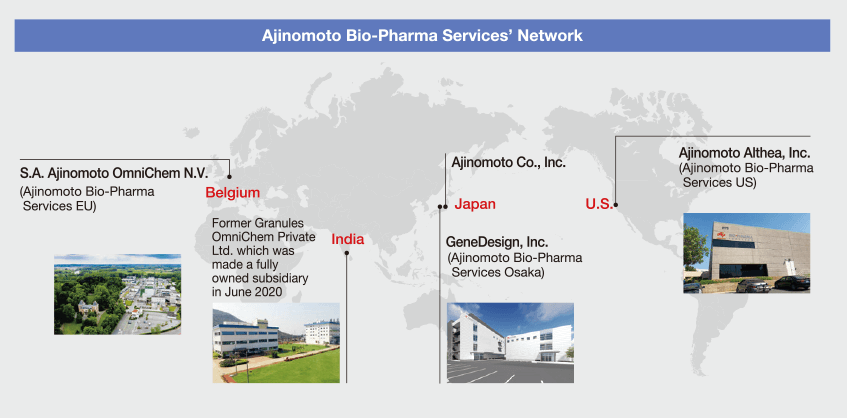The Ajinomoto Group FY2009–2019
In May 2019, the Ajinomoto Group marked the 110th anniversary of the launch of AJI-NO-MOTO®. The Group has prepared two reports concerning its operations over the decade since its first centennial, from April 2009 to March 2020: Ajinomoto Group History FY2009–2019 examines its management philosophies and strategies, while Ajinomoto Group Business & Corporate Overview FY2009–2019 takes a detailed look at its business and corporate policies.

The Ajinomoto Group did not reach its first centennial under entirely favorable winds. Foreign currency losses pushed consolidated results into the red for the fiscal year ended March 31, 2009. Moreover, stiff competition from large food multinationals and cut-price Asian producers, coupled with Japan’s declining birthrate and aging population, contributed further to the adverse business environment. So how has the Group turned the situation around? How did it transform itself, turning a V-shaped recovery into long-term sustainable growth, and work to meet stakeholders’ expectations? The following are some of the key concepts used in discussing the radical and innovative measures that were implemented to overcome the crisis: fair information sharing; building relationships of trust inside and outside the company; shift of priorities toward specialty retail from bulk (e.g. amino acids for feed, processed food ingredients such as sweeteners and MSG); Open & Link (proactive external partnerships), expansion into adjacent domains; and Ajinomoto Group Creating Shared Values (ASV), which emphasize both social and economic value and address Sustainable Development Goals for the environment, poverty, hunger, health, and more.

Open New Sky
To understand history is to understand the present. Every “now” is made up of processes and the will of many people.
Ajinomoto Group History
The Ajinomoto Group’s first century
AJI-NO-MOTO® owes its invention to a love of Japanese food and an idea inspired by the taste of broth made from kombu (kelp). Years of technological innovation and tireless promotional activities have brought the deliciousness of umami to Japan and the world. Toyonobu Domen was a leading figure in the international business community in Japan after World War II and a pioneering advocate of corporate social responsibility during the 1960s. As Ajinomoto’s fourth president, he demonstrated rare leadership in introducing modern marketing methods and diversifying the company’s businesses through international partnerships. The two decades starting from the end of the 20th century saw widespread utilization of amino acid technology and rapid overseas expansion. However, a growing dependence on bulk business would lead to global production and thus price competition.

Toyonobu Domen, Ajinomoto Co., Inc.’s fourth president
A Compass for the Ajinomoto Group’s Second Century
Top company executives discuss the Group’s centennial and their forecast for its next 100 years, from the deficit crisis and the structural reforms and growth strategies that turned things around, to the Group’s founding commitment to creating social and economic value, its contributions to improving both flavor and human health, and the future impact of globalization combined with digitalization.
Chairman of the Board
A key figure shares his thoughts on the difficulties that changes in climate and the environment pose for the animal nutrition and pharmaceutical industries; the 2008 global financial crisis; the management strategies that turned the deficit crisis into a V-shaped recovery and sustainable growth; the corporate philosophy embodied by ASV; and why eating is a fundamental human activity.
President & CEO
President Nishii sits down with a leading expert on Creating Shared Value to discuss issues that shed light on the future of the Ajinomoto Group. What made 2015 a turning point? How does ASV seek to create both social and economic value? Can lingering prejudice and misunderstanding surrounding MSG finally be dispelled? What are the Group’s strategies for future growth?
Challenges for the Ajinomoto Group’s Second Century
In tracing the Group’s management and business strategies since its centennial, the report summarizes the Group’s Medium-Term Management Plan and its results, looking specifically at policies related to: structural reform and the creation of growth drivers, and building strong relationships with stakeholders. A concise overview of the Group’s two main businesses, food and amino acid technology, provides insight into the development of new markets, products, marketing, R&D, production, and organizational structures. Finally, the FY2020-2022 Medium-Term Management Plan, which looks ahead to 2030, is discussed in the context of the Group’s future direction.

TAI PEI® Pork Potstickers & Chicken Fried Rice and Ling Ling® Mini Spring Rolls & Potstickers (as marketed in 2014)

World Umami Forum (New York City, September 2018)
Appendices
A series of tables and graphs fully illustrates the evolution of the Group’s financial situation, executive and employee data, organization and structure, etc. over the course of the decade since its centennial.
Ajinomoto Group History Index
- Message
- Cover, Title page and Index
- Chapter I
- Chapter II
- Chapter III, Sections 1-2
- Chapter III, Sections 3-5
- Chapter IV
- Postscript
- The History of the Ajinomoto Group (Full Version)
Business & Corporate Outline
A comprehensive description of the Ajinomoto Group’s policies since 2009. Read in conjunction with the strategy-centered History, this report provides a more three-dimensional and dynamic understanding of the diversity and evolution of the Group’s activities. Concerning its two main businesses, food and amino acid technology, the report discusses in detail issues relating to the environment, the development of new markets, product development, and marketing of major products in each area. It also traces how the Group has utilized its core strengths to create new products and services in response to social changes in nutrition, health, the environment, and people’s lifestyles, as well as to competition and other changes in the business environment. The corporate overview section explains the background and processes behind organizational restructuring and functional reforms implemented in support of the Group, most notably efforts regarding intellectual property, advertising, and public relations aimed at forging a truly global company.

Examples of expansion into adjacent domains in the domestic food business:
Cook Do® Kyo-no Ohzara® and Nabe Cube® Chicken Dashi/Umami-salt Flavor

Business & Corporate Outline Index
- Cover, Title page, Index
- Food business (Consumer food business in Japan and overseas (seasonings/packaged foods/frozen foods ) etc.)
- Food business (Deliciousness solutions, group companies etc.)
- AminoScience business (Business outline, Animal nutrition business, Specialty chemical business, etc.)
- Corporate (Intellectual property, Advertising, Public Communications, etc.)
- Business/Corporate Outline complete version
